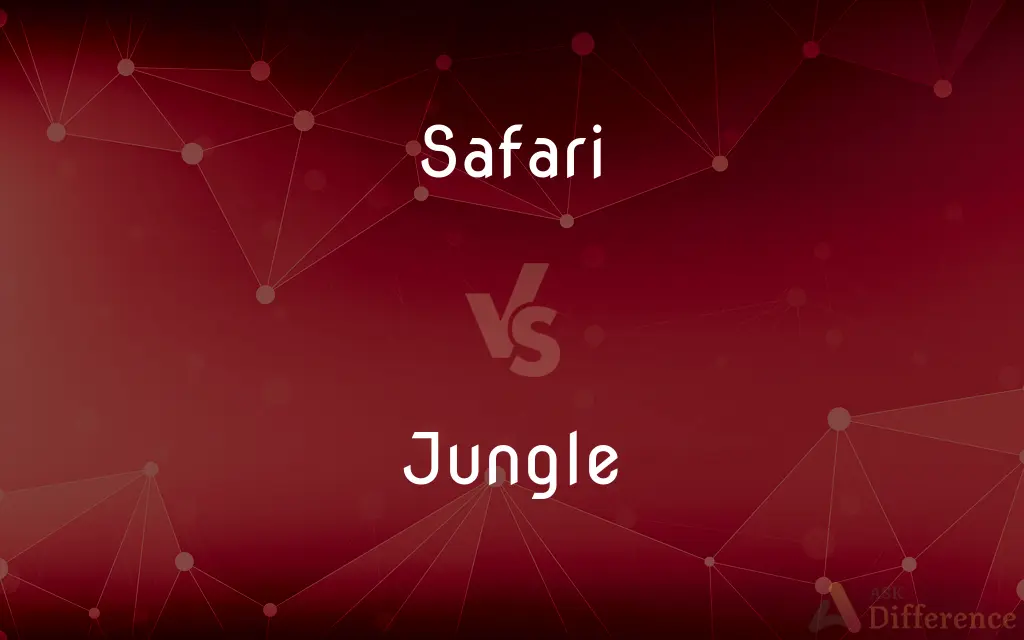Safari vs. Jungle — What's the Difference?
Edited by Tayyaba Rehman — By Urooj Arif — Updated on March 25, 2024
A safari is an expedition to observe or hunt wildlife in their natural habitat, primarily in Africa, whereas a jungle refers to a dense, wild forest in tropical regions, rich in biodiversity.

Difference Between Safari and Jungle
Table of Contents
ADVERTISEMENT
Key Differences
A safari is an adventure or expedition often associated with the African continent, where individuals embark on trips to observe, photograph, or sometimes hunt wildlife in natural reserves or parks. The term has evolved to signify a tourist activity focused on experiencing and appreciating wildlife in its natural environment, often involving guided tours. In contrast, a jungle is a specific type of dense and impenetrable forest found in tropical areas, characterized by a high level of rainfall, humidity, and biodiversity. Jungles are ecosystems teeming with a wide variety of flora and fauna, offering a habitat for countless species, from insects to large mammals.
While the concept of a safari is closely tied to human activities and the desire to explore or connect with the natural world, a jungle represents a natural environment itself, largely untouched by human development. Safaris are planned and organized with specific goals, such as wildlife viewing or conservation efforts, and are conducted with respect for the natural habitats being visited. On the other hand, jungles are wild areas that function as critical components of the earth's ecosystem, often requiring conservation efforts to protect them from deforestation and other threats.
The experience of a safari is shaped by human interaction with wildlife and nature, aiming to offer a deeper understanding and appreciation of biodiversity. Contrastingly, jungles can be seen as the backdrop for such interactions, providing the complex and lush environments where wildlife thrives. While safaris bring people into direct contact with the wonders of the natural world, jungles challenge human survival skills and have often been depicted as mysterious and untamed landscapes in literature and media.
Moreover, the purpose of a safari often includes education, conservation, and the economic benefit of local communities through eco-tourism. Jungles, however, serve broader ecological roles, such as carbon storage, climate regulation, and supporting indigenous communities who live in or near them. The preservation of jungles is crucial for biodiversity and the global environment, while safaris, when conducted responsibly, can contribute to the conservation of wildlife and their habitats.
Comparison Chart
Efinition
An expedition to observe or hunt wildlife in their natural habitat.
A dense, tropical forest with high biodiversity.
ADVERTISEMENT
Purpose
Wildlife observation, photography, conservation, and eco-tourism.
Ecosystem functioning, biodiversity conservation, and habitat for species.
Location
Primarily in Africa, but also in other regions with natural reserves.
Tropical regions around the equator with high rainfall.
Human Interaction
Organized activities with goals of exploration and conservation.
Minimal to none; jungles are largely wild and untouched.
Ecological Role
Supports conservation through eco-tourism and education.
Provides critical habitat for biodiversity and plays a key role in global ecology.
Experience
Human-centered, focusing on observing and appreciating wildlife.
Nature-centered, highlighting survival and exploration in wild conditions.
Conservation
Often involves efforts to protect wildlife and their habitats.
Focuses on protecting the jungle ecosystem from threats like deforestation.
Compare with Definitions
Safari
A trip to observe wildlife.
They went on a safari in Kenya to see lions in the wild.
Jungle
Challenging terrain.
Navigating the jungle requires skill and knowledge of the terrain.
Safari
Eco-tourism adventure.
The safari offered insights into elephant conservation.
Jungle
Dense tropical forest.
The Amazon jungle is the world's largest tropical rainforest.
Safari
Hunting expeditions (historically).
Safaris were once popular among hunters seeking big game.
Jungle
High biodiversity area.
Jungles are home to a vast array of plant and animal species.
Safari
Guided wildlife tours.
Our safari guide explained the behaviors of various animals.
Jungle
Ecosystem with high rainfall.
Jungles receive more rainfall than any other terrestrial ecosystem.
Safari
Conservation efforts.
The safari park contributes to rhino protection initiatives.
Jungle
Habitat for indigenous communities.
Indigenous people have lived in the jungle for centuries, relying on its resources.
Safari
A safari (Swahili: safari) is an overland journey to hunt or (in more recent times) observe wild animals, especially in east or southern Africa. The so-called Big Five game animals of Africa – lion, leopard, rhinoceros, elephant, and Cape buffalo – particularly form an important part of the safari market, both for wildlife viewing and big-game hunting.
Jungle
A jungle is land covered with dense forest and tangled vegetation, usually in tropical climates. Application of the term has varied greatly during the past recent centuries.
Safari
An overland expedition, especially one for hunting or viewing wildlife in eastern Africa.
Jungle
Land covered with a dense growth of tropical vegetation.
Safari
A trip into any undeveloped area to see, photograph or hunt wild animals in their own environment.
Jungle
A dense thicket or growth.
Safari
A caravan going on a safari.
Jungle
A dense, confused mass; a jumble.
Safari
(by extension) Any trip for the purpose of discovering something new or acquiring prizes or trophies.
Jungle
Something made up of many confused elements; a bewildering complex or maze
Sorting through the jungle of regulations.
Safari
(intransitive) To take part in a safari.
Jungle
A place or milieu characterized by intense, often ruthless competition or struggle for survival
The corporate jungle.
Safari
An overland journey by hunters (especially in Africa)
Jungle
(Slang) A place where hoboes camp.
Jungle
A large, undeveloped, humid forest, especially in a tropical region, that is home to many wild plants and animals; a tropical rainforest.
Jungle
(South Asia) Any uncultivated tract of forest or scrub habitat.
Jungle
(colloquial) A place where people behave ruthlessly, unconstrained by law or morality.
It’s a jungle out there.
Jungle
(figurative) A tangled mess.
Jungle
(slang) An area where hobos camp together.
Jungle
(UK) A migrant camp.
Jungle
A style of electronic dance music and precursor of drum and bass.
Jungle
A desert region.
Jungle
Dense rough.
Tiger country
Jungle
A hairy vulva.
Jungle
(Of musical beat, rhythm, etc.) resembling the fast-paced drumming of traditional peoples of the jungle.
Jungle
A dense growth of brushwood, grasses, reeds, vines, etc.; an almost impenetrable thicket of trees, canes, and reedy vegetation, as in India, Africa, Australia, and Brazil.
The jungles of India are of bamboos, canes, and other palms, very difficult to penetrate.
Jungle
A place of danger or ruthless competition for survival.
Jungle
Anything which causes confusion or difficulty due to intricacy; as, a jungle of environmental regulations.
Jungle
An impenetrable equatorial forest
Jungle
A location marked by an intense competition and struggle for survival
Jungle
A place where hoboes camp
Common Curiosities
How do safaris contribute to conservation?
Safaris can support conservation through eco-tourism revenues, education, and by raising awareness of wildlife protection needs.
Can safaris be found outside of Africa?
Yes, while traditionally associated with Africa, safaris are also conducted in other regions with significant wildlife populations.
What defines a jungle?
A jungle is a dense, tropical forest characterized by high rainfall, humidity, and a diverse array of flora and fauna.
Why are jungles important?
Jungles play crucial roles in global ecology, such as carbon storage, climate regulation, and preserving biodiversity.
Are safaris always about hunting?
Historically, yes, but modern safaris focus more on wildlife observation, photography, and conservation.
What is a safari?
A safari is an expedition focused on observing, photographing, or hunting wildlife in their natural settings, often emphasizing conservation and eco-tourism.
Can safaris be harmful to wildlife?
If not managed responsibly, safaris can disturb wildlife, but many are designed to minimize impact and support conservation.
How are jungles different from other forests?
Jungles are denser and located in tropical regions with higher temperatures and rainfall compared to other forest types.
How do I prepare for a jungle expedition?
Preparing for a jungle expedition involves researching the area, getting vaccinations, packing appropriate gear, and often hiring experienced guides.
Why is jungle conservation important?
Conserving jungles is vital for maintaining biodiversity, supporting indigenous cultures, and preserving essential ecological functions.
What kind of wildlife can be seen on a safari?
Depending on the location, safaris can feature a range of wildlife, including lions, elephants, giraffes, and various bird species.
What is eco-tourism in relation to safaris?
Eco-tourism focuses on sustainable travel that conserves environments and improves the well-being of local people, often associated with safaris.
What challenges do jungles face?
Jungles face threats from deforestation, habitat destruction, and climate change, impacting biodiversity and indigenous communities.
Do people live in jungles?
Yes, many indigenous communities live in or near jungles, relying on them for their livelihoods and culture.
What activities are involved in a safari?
Safari activities include game drives, walking tours, bird watching, and sometimes participation in conservation projects.
Share Your Discovery

Previous Comparison
Waveform vs. Spectrogram
Next Comparison
Barycentre vs. CentroidAuthor Spotlight
Written by
Urooj ArifUrooj is a skilled content writer at Ask Difference, known for her exceptional ability to simplify complex topics into engaging and informative content. With a passion for research and a flair for clear, concise writing, she consistently delivers articles that resonate with our diverse audience.
Edited by
Tayyaba RehmanTayyaba Rehman is a distinguished writer, currently serving as a primary contributor to askdifference.com. As a researcher in semantics and etymology, Tayyaba's passion for the complexity of languages and their distinctions has found a perfect home on the platform. Tayyaba delves into the intricacies of language, distinguishing between commonly confused words and phrases, thereby providing clarity for readers worldwide.
















































